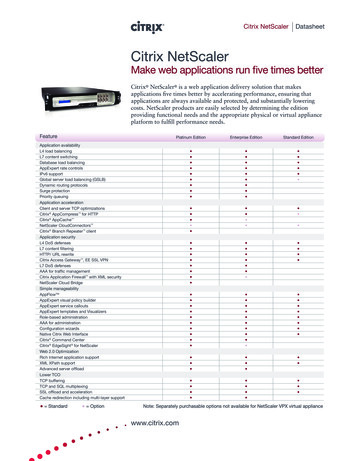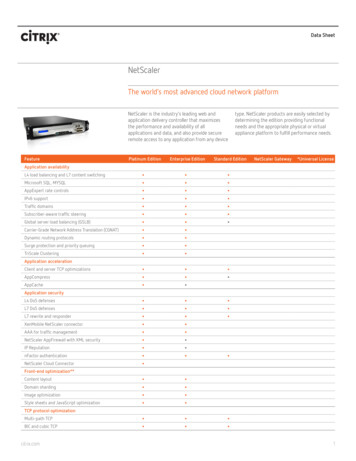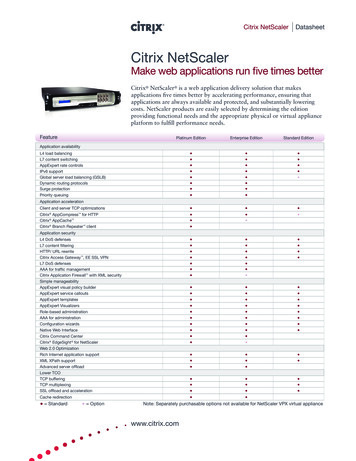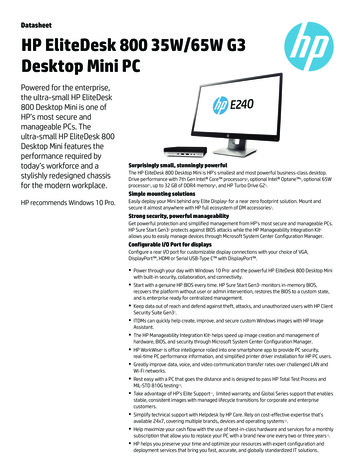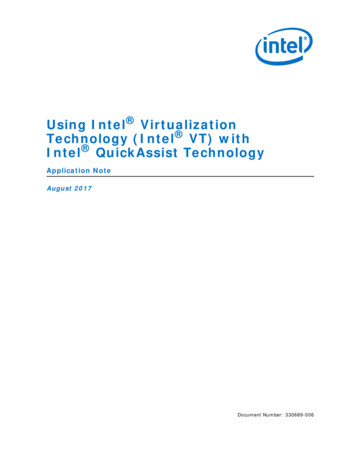
Transcription
Intel MPX Explained:A Cross-layer Analysis of the Intel MPX System Stack https://Intel-MPX.github.io/OLEKSII OLEKSENKO and DMITRII KUVAISKII, TU Dresden, GermanyPRAMOD BHATOTIA, The University of Edinburgh, United KingdomPASCAL FELBER, University of Neuchâtel, SwitzerlandCHRISTOF FETZER, TU Dresden, GermanyMemory-safety violations are the primary cause of security and reliability issues in software systems writtenin unsafe languages. Given the limited adoption of decades-long research in software-based memory safetyapproaches, as an alternative, Intel released Memory Protection Extensions (MPX)Ða hardware-assistedtechnique to achieve memory safety. In this work, we perform an exhaustive study of Intel MPX architecturealong three dimensions: (a) performance overheads, (b) security guarantees, and (c) usability issues.We present the first detailed root cause analysis of problems in the Intel MPX architecture through across-layer dissection of the entire system stack, involving the hardware, operating system, compilers, andapplications. To put our findings into perspective, we also present an in-depth comparison of Intel MPX withthree prominent types of software-based memory safety approaches. Lastly, based on our investigation, wepropose directions for potential changes to the Intel MPX architecture to aid the design space exploration offuture hardware extensions for memory safety.CCS Concepts: · Security and privacy Software security engineering;Additional Key Words and Phrases: Memory safety; ISA extensions; Intel MPXACM Reference Format:Oleksii Oleksenko, Dmitrii Kuvaiskii, Pramod Bhatotia, Pascal Felber, and Christof Fetzer. 2018. Intel MPXExplained: A Cross-layer Analysis of the Intel MPX System Stack: https://Intel-MPX.github.io/. Proc. ACMMeas. Anal. Comput. Syst. 2, 2, Article 28 (June 2018), 30 pages. https://doi.org/10.1145/32244231 INTRODUCTIONThe majority of critical software systems is written in low-level languages such as C or C . Theselanguages give programmers explicit and fine-grained control over memory, which is especiallyimportant for development of efficient software systems. Unfortunately, the ability to directlycontrol memory often leads to violations of memory safety properties, i.e., illegal accesses tounintended memory regions [53]. Thepaper presents only the summarized resultsÐthe detailed analysis is published on our website: https://IntelMPX.github.io/. Clicking on most figures/plots and (sub-)section headings in the paper will open a corresponding webpage.Authors’ addresses: Oleksii Oleksenko; Dmitrii Kuvaiskii, TU Dresden, Dresden, Germany, {firstname.lastname}@tu-dresden.de; Pramod Bhatotia, The University of Edinburgh, Edinburgh, United Kingdom, pramod.bhatotia@ed.ac.uk; Pascal Felber,University of Neuchâtel, Neuchâtel, Switzerland, pascal.felber@unine.ch; Christof Fetzer, TU Dresden, Dresden, Germany,Christof.Fetzer@tu-dresden.de.Permission to make digital or hard copies of all or part of this work for personal or classroom use is granted without feeprovided that copies are not made or distributed for profit or commercial advantage and that copies bear this notice andthe full citation on the first page. Copyrights for components of this work owned by others than ACM must be honored.Abstracting with credit is permitted. To copy otherwise, or republish, to post on servers or to redistribute to lists, requiresprior specific permission and/or a fee. Request permissions from permissions@acm.org. 2018 Association for Computing Machinery.2476-1249/2018/6-ART28 15.00https://doi.org/10.1145/3224423Proc. ACM Meas. Anal. Comput. Syst., Vol. 2, No. 2, Article 28. Publication date: June 2018.28
28:2O. Oleksenko et al.In particular, memory-safety violations emerge in the form of spatial and temporal errors. SpatialerrorsÐbuffer overflows and out-of-bounds accessesÐoccur when a program reads from or writesto a different memory region than the one expected by the developer. Temporal errorsÐwild anddangling pointersÐappear when trying to use an object before it was created or after it was deleted.These memory-safety violations are the root cause of most reliability and security vulnerabilitiesin legacy software systems [50]. Given its importance, over decades, a plethora of solutions havebeen proposed for enforcing memory safety in unsafe languages, ranging from static analysis tolanguage extensions [1, 4, 12, 19, 28, 30, 32, 35, 37, 38, 40, 46, 58].In this work, we concentrate on deterministic dynamic bounds-checking since it is widely regardedas the only way of defending against all memory safety attacks [34, 50]. Bounds-checking techniquesaugment the original unmodified program with metadata (bounds of live objects or allowed memoryregions) and insert checks against this metadata before each memory access. Unfortunately, thestate-of-the-art software-based approaches have seen limited adoption in practice, largely owing tohigh performance overhead (50ś150%), incomplete security guarantees, and incompatibility withlegacy libraries.To overcome these limitations, Intel released Memory Protection Extensions (Intel MPX)Ða set ofnew ISA extensions as part of the Skylake microarchitecture [22, 23]. Its underlying idea is to providehardware assistance for enforcing memory safety, in the form of new instructions and registers, asan alternative to the software-based approaches. Through its cross-layer support, involving thehardware, operating system, compiler, and application levelsÐthe Intel MPX architecture promisesto address the performance, security, and compatibility issues of previous software-only approaches.In this paper, we showcase that Intel MPX has flaws in all three important dimensions: (a)performance and memory overheads, (b) security guarantees, and (c) usability issues. Performanceis important because only solutions with low (up to 10ś20%) runtime overhead have a chance to beadopted in practice [50]. Security assessment of the available implementation on a diverse set ofmemory vulnerabilities is required to verify advertised security guarantees. And lastly, usabilitygives us insights on application-specific issues that arise when using the Intel MPX system stackand need to be manually fixed.This work presents the first detailed cross-layer dissection of the Intel MPX system stack,comprising the hardware, operating system, compilers, and applications. Our work provides insightson the causes of overheads, security, and usability issues in both the Intel MPX architecture andits surrounding infrastructure. To fully explore Intel MPX’s pros and cons, we put the resultsinto perspective by comparing with existing software-based solutions. In particular, we comparedIntel MPX with three prominent classes of memory safety: trip-wire Ð AddressSanitizer [46],object-basedÐSAFECode [12], and pointer-basedÐSoftBound [35]. Surprisingly, even though IntelMPX is a specially designed hardware-assisted approach, it is not faster than the software-basedapproaches.We investigate Intel MPX and the aforementioned software-based approaches using a comprehensive range of micro-benchmarks and benchmark suites. Our investigation reveals that althoughIntel MPX strives to solve an important problem, it is not yet practical because of the followingissues: New Intel MPX instructions are not as fast as expected and cause up to 4 slowdown in theworst case, although compiler optimizations amortize it and lead to runtime overheads of 50% on average. In contrast to other solutions, Intel MPX provides no protection against temporal memorysafety errors.Proc. ACM Meas. Anal. Comput. Syst., Vol. 2, No. 2, Article 28. Publication date: June 2018.
Intel MPX Explained28:3 Intel MPX does not support multithreading inherently, which can lead to unsafe data racesin legacy threaded programs and if compilers do not synchronize bounds explicitly. Intel MPX does not support several common C/C programming idioms due to restrictionson the allowed memory layout. In our experiments, 8ś13% programs did not run correctlywithout substantial code changes and additionally, 18% required non-intrusive manual fixes. Intel MPX is conflicting with some other ISA extensions resulting in performance issues.More specifically, we investigated the issues that arise when Intel MPX is used in combinationwith Intel TSX and Intel SGX. Lastly, MPX instructions incur significant performance penalty (15 %) even on earlier IntelCPU generations without MPX support (e.g., Haswell).Note that some of these flaws could be fixed by making a few minor changes to Intel MPX.Specifically, there are relatively straightforward ways of implementing temporal safety, and thecompatibility problems could probably be fixed too. Yet, most of the performance and usabilityissues are fundamental and would require substantial changes to the design of Intel MPX.As of less critical issues, the supporting compiler infrastructure (compiler passes and runtimelibraries) is not mature enough and has bugs, such that 3ś10% programs cannot compile/run. Fortunately, these issues could be resolved by improving the toolchain, in contrast to the aforementionedfundamental issues that require hardware modifications.All these issues created a growing trend of re-purposing Intel MPX to provide coarse-grainedisolation of memory regions. In particular, out of the whole MPX stack, only two bounds-checkinginstructions are usually employed to provide efficient Software Fault Isolation [7, 26, 29, 33, 42].Meanwhile, we know of no successful attempts to use MPX for the original purpose of completememory safety. In fact, the interest of using Intel MPX for its direct purpose has become so little,that GCC is deprecating the feature in GCC 9 [41].Nevertheless, there is an urgent need for a lightweight practical hardware-assisted memorysafety mechanism to end the eternal war in memory [50]. Based on our findings, we proposepotential directions for extensions to the Intel MPX architecture to address three important issues:(1) performance and memory overheads, (2) security properties, and (3) transparent multithreading support. Our work seeks to help in paving the way for future correct-by-design hardwaretechnologies.To summarize, our paper makes the following contributions: We present the first detailed analysis of problems in the Intel MPX architecture through across-layer dissection of the entire MPX system stack (§3). To put our findings into perspective, we present a comparison of Intel MPX with threeprominent types of software-based memory safety approaches (§4). Lastly, we suggest future directions for potential improvements to the MPX architecture (§6).2 BACKGROUNDBefore we delve into the details of the Intel MPX architecture, we first present a brief backgroundon state-of-the art software-based memory safety approaches. We analyze and evaluate theseapproaches to put the design and results of MPX into perspective.All spatial and temporal bugs, as well as memory attacks built on such vulnerabilities, are causedby an access to a prohibited memory region. Accordingly, to prevent such errors, memory safetymust be imposed on the program, i.e., the following invariant must be enforced: memory accessesmust always stay within the originally intended (referent) objects.To this end, software-based runtime bounds-checking techniques are used, broadly classifiedas trip-wire, object-based, and pointer-based [34]. For comparison with Intel MPX, we chose aProc. ACM Meas. Anal. Comput. Syst., Vol. 2, No. 2, Article 28. Publication date: June 2018.
28:4O. Oleksenko et al.(a) Trip-wire:AddressSanitizer(b) Object-based:SAFECodeshadow memory(c) Pointer-based:SoftBoundshadow memoryPool 1secondary trieobj shadowLBPool 2redzoneobjUB key lockprimary trieobjobjptrptrredzoneptrFig. 1. Designs of three memory-safety classes.prominent example from each of the three classes: AddressSanitizer, SAFECode, and SoftBound(Figure 1 highlights the differences between them).Trip-wire approach: AddressSanitizer [46]. This class surrounds all objects with regions ofmarked (poisoned) memory called redzones, so that any overflow will change values in thisÐotherwise invariableÐregion and will be consequently detected [19, 20, 38, 46]. In particular,AddressSanitizer reserves 1/8 of all virtual memory for the shadow memory at program startup; thememory is accessed only by the instrumentation and not the original program. AddressSanitizerupdates data in the shadow memory whenever a new object is created and freed, and inserts checkson shadow memory before memory accesses to objects. The check itself looks like this:shadowAddr MemToShadow(ptr)if (ShadowIsPoisoned(shadowAddr)) Error()In addition, AddressSanitizer provides means to probabilistically detect temporal errors via aquarantine zone: if a memory region has been freed, it is kept in the quarantine for some timebefore it becomes allowed for reuse.AddressSanitizer was built for debugging purposes and is not targeted for security. It is sometimesused in this context for the lack of better alternatives [6, 34] but such use is discouraged [55] (e.g.,because attackers may abuse the debugging features in AddressSanitizer’s run-time library). Forexample, it may not detect non-contiguous out-of-bounds violations. Nevertheless, it detects manyspatial bugs and significantly raises the bar for the attacker. It is also the most widely-used techniquein its class, comparing favorably to other trip-wire techniques such as LBC [19], Purify [20], andValgrind [38].Object-based approach: SAFECode [11, 12]. This class’s main idea is enforcing the intendedreferent, i.e., making sure that pointer manipulations do not change the pointer’s referent object [1,11, 12, 14ś16, 44]. In SAFECode, this rule is relaxed: each object is allocated in one of severalfine-grained partitionsÐpoolsÐdetermined at compile-time using pointer analysis; the pointer mustalways land into the predefined pool. This technique allows powerful optimizations and simpleruntime checks against the pool bounds:poolAddr MaskLowBits(ptr)if (poolAddr not in predefinedPoolAddrs) Error()In addition, we considered other object-based approaches. CRED [44] has huge performanceoverheads, mudflap [16] is deprecated in newer versions of GCC, and Baggy Bounds Checking [1]and Low-Fat Pointers [14, 15] are not open sourced.Proc. ACM Meas. Anal. Comput. Syst., Vol. 2, No. 2, Article 28. Publication date: June 2018.
Intel MPX Explained28:5(a) Original code123456struct obj { char buf[100]; int len }obj a[10]for (i 0; i M; i ):ai a iobjptr load ailenptr objptr 100len load lenptr;; Array of pointers to objs;; M may be greater than 10;; Pointer arithmetic on a;; Pointer to obj at a[i];; Pointer to obj.len(b) Intel MPX123456789101112obj a[10]a b bndmk a, a 79for (i 0; i M; i ):ai a ibndcl a b, aibndcu a b, ai 7objptr load aiobjptr b bndldx ailenptr objptr 100bndcl objptr b, lenptrbndcu objptr b, lenptr 3len load lenptr;; Make bounds [a, a 79];; Lower-bound check of a[i];; Upper-bound check of a[i];; Bounds for pointer at a[i];; Checks of obj.len ⌉⌋Fig. 2. Example of bounds checking using Intel MPX.Pointer-based approach: SoftBound [35, 36]. Such approaches keep track of pointer bounds(the lowest and the highest address the pointer is allowed to access) and check each memorywrite and read against them [25, 32, 35ś37, 47]. Note how SoftBound associates metadata not withan object but rather with a pointer to the object. This allows pointer-based techniques to detectintra-object overflows (one field overflowing into another field of the same struct) by narrowingbounds associated with the particular pointer.For our comparison, we used the SoftBound CETS version which keeps pointer metadata in atwo-level trieÐsimilar to MPX’s bounds tablesÐand introduces a scheme to protect against temporalerrors [36]. The checks are as follows:LB,UB,key,lock TrieLookup(ptr)if (ptr LB or ptr UB or key ! lock) Error()As for other pointer-based approaches, MemSafe [47] is not open sourced, and CCured [37],Cyclone [25], and CheckedC [32] require manual changes in programs.3 ANALYSIS OF THE INTEL MPX STACKIntel Memory Protection Extension (MPX) provides a hardware assisted pointer-based mechanismfor memory safety. It is a cross-layer solution: (i) hardware layer introduces new instructions andregisters to operate on pointer bounds, (ii) operating system layer provides support for memorymanagement and exception handling, (iii) compiler and runtime layer adds instrumentation passesand wrappers, and (iv) application layer allows for MPX-specific changes in programs. In thefollowing section, we separately analyze each layer of the Intel MPX system stack.Proc. ACM Meas. Anal. Comput. Syst., Vol. 2, No. 2, Article 28. Publication date: June 2018.
28:6O. Oleksenko et al.Instructionbndmk b,mbndcl b,mbndcl b,rbndcu b,mbndcu b,rbndmov b,mbndmov b,bbndmov m,bbndldx b,mbndstx m,bDescriptioncreate pointer boundscheck mem-operand against lower boundcheck reg-operand against lower boundcheck mem-operand against upper boundcheck reg-operand against upper boundmove pointer bounds from memorymove pointer bounds to other registermove pointer bounds to memoryload pointer bounds from BTstore pointer bounds in BTLatency Throughput1211121112111220.54-60.44-60.3Note: bndcu has a one’s complement version; we skip it for clarityTable 1. Latency (cycles/instr) and throughput (instr/cycle) of Intel MPX instructions; bÐMPX bounds register;mÐmemory operand; rÐgeneral-purpose register operand.Before going into details, we give a brief overview of MPX on a simple example shown inFigure 2a. The original program allocates an array a[] with 10 pointers to objects of type obj (Line1). Next, it iterates through the first M array items to read the objects’ lengths (Lines 2ś6). Since Mis a variable, a bug may set M to a value that is larger than 10 and an overflow will happen.Figure 2b shows the code with Intel MPX enabled. First, the bounds for the array a[] are createdon Line 2 (the array contains 10 pointers each 8 bytes wide, hence the upper-bound offset of 79).Then in the loop, before the array item access on Line 7, two MPX bounds checks are inserted todetect if a[i] overflows (Lines 5ś6).Now that the pointer to the object is loaded in objptr, the program wants to load the obj.lensubfield. By design, Intel MPX must protect this second load by checking the bounds of the objptrpointer. Thus, the bounds are first loaded via bndldx instruction (Line 8) and then the two boundschecks are inserted before the load of the length value on Lines 10ś11 (narrowing of bounds is notshown for simplicity, see §3.3).3.1HardwareAt its core, Intel MPX provides 7 new instructions and a set of 128-bit bounds registers. The Skylakearchitecture provides four registers named bnd0śbnd3. Each of them stores a lower bound in bits0ś63 and an upper bound in bits 64ś127.Instruction set. The new MPX instructions are: bndmk to create new bounds, bndcl and bndcu/bndcnto compare the pointer value against the lower and upper bounds in bnd respectively, bndmov tomove bounds from one bnd register to another and to spill them to stack, and bndldx/bndstx toload/store pointer bounds in special Bounds Tables respectively.It is interesting to compare the benefits of hardware implementation of bounds-checking againstthe software-only counterpartÐSoftBound [35, 36]. First, Intel MPX introduces separate bounds registers to lower register pressure on the general-purpose register file, something that software-onlyapproaches suffer from. Second, dedicated bndcl and bndcu instructions substitute the softwarebased łcompare and branchž instruction sequence, saving one cycle and exerting no pressure onbranch predictor.Storing bounds in memory. The current version of Intel MPX has only 4 bounds registers, whichis clearly not enough for real-world programs. All additional bounds have to be stored (spilled)in memory, similar to spilling data out of registers. A simple and fast option is to copy themProc. ACM Meas. Anal. Comput. Syst., Vol. 2, No. 2, Article 28. Publication date: June 2018.
Intel MPX Explained28:7① bndmk ② bndcl/bndcu ③ bndmov ④ bndldx ⑤ bndstxport 0Int ALUVECBranch①②③④port 1Int ALUVECALU①②③④⑤port 2LoadStore③④⑤port 4ALUShiftStoreport 3LoadStore③④⑤③⑤port 6port 5ALUVECLEA①③④①②③④port 7Store③⑤Fig. 3. Distribution of Intel MPX instructions among execution ports (Intel Skylake).directly on stack with bndmov. However, it works only inside a single stack frame: if a pointer islater reused in another function, its bounds will be lost. To solve this issue, two instructions wereintroducedÐbndstx and bndldx. They store/load bounds to/from a memory location derived fromthe address of the pointer itself (see Figure 2b, Line 8), thus making it easy to find pointer boundswithout any additional information, though at a price of higher complexity.When bndstx and bndldx are used, bounds are stored in a memory location calculated withtwo-level address translation scheme, similar to virtual address translation. In particular, eachpointer has an entry in a Bounds Table (BT), which is allocated dynamically and is comparableto a page table. Addresses of BTs are stored in a Bounds Directory (BD). For a specific pointer, itsentries in the BD and the BT are derived from the memory address in which the pointer is stored. Incontrast to virtual address translation, no dedicated hardware like MMU or TLB cache is introduced,thus Intel MPX can experience performance degradation caused by cache thrashing (see §4.1).Figure 4 shows pointer address translation on the example of bndldx. In the first stage, the CPU:① extracts the offset of BD entry from bits 20ś47 of the pointer address and shifts it by 3 bits (sinceall BD entries are 23 bits long), ② loads the base address of BD from the BNDCFGx register, and ③sums the base and the offset and loads the BD entry from the resulting address. In the second stage,the CPU: ④ extracts the offset of BT entry from bits 3ś19 of the pointer address and shifts it by5 bits (since all BT entries are 25 bits long), ⑤ shifts the loaded entryÐwhich corresponds to thebase of BTÐby 3 to remove the metadata, and ⑥ sums the base and the offset and ⑦ finally loadsthe BT entry from the resulting address. Note that a BT entry has an additional łpointerž fieldÐifthe actual pointer value and the value in this field mismatch, Intel MPX will mark the bounds asalways-true (INIT), required for interoperability with legacy code.This address translation mechanism is expensiveÐit requires approximately 3 register-to-registermoves, 3 shifts, and 2 memory loads. On top of it, since these 2 loads are non-contiguous, theprotected application has worse cache locality.Analysis. As the first step in our evaluation, we measured latency and throughput of MPX instructions (Table 1), as well as their distribution among execution ports (Figure 3). The major bottleneckis storing/loading the bounds with bndstx and bndldx since they undergo a complex algorithm ofaccessing bounds tables.In our measurement study (§4), we observed that Intel MPX protection does not increase theIPC (instructions/cycle) of programs, which is usually the case for memory-safety techniques (seeFigure 11). This was surprising: we expected that Intel MPX would take advantage of underutilizedCPU resources for programs with low original IPC. To understand what causes this bottleneck, wemeasured the throughput of typical MPX check sequences.Proc. ACM Meas. Anal. Comput. Syst., Vol. 2, No. 2, Article 28. Publication date: June 2018.
28:8O. Oleksenko et al.ReservedPointerUBoundLBound64 630Bounds Table⑥ re-execute ⑦ continuestore⑥ addUBound LBound127⑦ LoadBounds Directory⑤ shift by 3④ shift by 5③ loadbase of BTBNDCFGxbase of BD② add3-19pointer address① shift by 3OS③ if BDE is empty:raise #BRCPU④ allocate BT⑤storenewBDE② load BDEBounds TableBounds Directory① store boundsApplicationSTARTHEREFig. 5. The procedure of Bounds Table creation.20-47Fig. 4. Loading of pointer bounds in IntelMPX.(a ) Only loa dL o ad 1L o ad 2L o ad 1L o ad 2L o ad 1L o ad 2L o ad 1L o ad 2(b) Dire c t bounds c he c k s a ndloadL o ad 1L o ad 1L o ad 2L o ad c ) Re la tiv e boundschecks and loadL o ad 1L o ad 2BNDCL1BNDCU1BNDCL2BNDCU2Fig. 6. Bottleneck of bounds checking illustrated.The measurements pointed to a bottleneck of bndcl/u b,m instructions due to contention ona single execution port. Without checks (Figure 6a), our original benchmark could execute twoloads in parallel, achieving a throughput of 2 IPC (note that the loaded data is always in a MemoryOrdering Buffer). After adding bndcl/u b,r checks (Figure 6b), IPC increased to three instructionsper cycle (3 IPC): one load, one lower-, and one upper-bound check per cycle. For bndcl/u b,mchecks (Figure 6 c), however, IPC became less than original: two loads and four checks werescheduled in four cycles, thus IPC of 1.5. In summary, the final IPC was 1.5ś3 (compare to originalIPC of 2), proving that the MPX-protected program typically has approximately the same IPC as theoriginal. (This causes major performance degradation, as Figures 9 and 10 show.)3.2Operating SystemThe OS has two main responsibilities in the context of Intel MPX: it handles bounds violations andmanages BTs, i.e., creates and deletes them. Both these actions are hooked to a new exception class,#BR, introduced solely for Intel MPX.Bounds exception handling. If an MPX-enabled CPU detects a bounds violation, #BR is raisedand the processor traps into the kernel. The kernel gets the violating address and bounds anddelivers them to the application using the SIGSEGV signal. At this point the application developerhas a choice: she can either provide an ad-hoc signal handler to recover or choose one of the defaultpolicies: crash, print an error, or ignore it.Bounds tables management. Two levels of bounds address translation are managed differently:BD is allocated only once by a runtime library (at program startup) and BTs have to be createdProc. ACM Meas. Anal. Comput. Syst., Vol. 2, No. 2, Article 28. Publication date: June 2018.
Intel MPX ExplainedType28:9Increase in # of instructions (%)Slowdown User space Kernel spaceallocation2.33 7.5160 de-allocation2.25 10139Table 2. Worst-case OS impact on performance of MPX.dynamically on-demand. The later is a task of OS. The procedure is presented in Figure 5. Eachtime an application tries to store pointer bounds ①, the CPU loads the corresponding entry fromthe BD and checks if it is a valid entry ②. If the check fails, the CPU raises #BR and traps into thekernel ③. The kernel allocates a new BT ④, stores its address in the BD entry ⑤ and returns in theuser space ⑥. Then, the CPU stores bounds in the newly created BT and continues executing theapplication in the normal mode of operation ⑦. Since the application is oblivious to BT allocation,the OS also frees these tables when they become unused.Analysis. To illustrate the additional overhead of allocating and de-allocating BTs, we created twomicrobenchmarks.The first one indirectly creates a large amount of BTs by storing a set of pointersin sparse memory locations. The second one, in addition, frees all the memory right after it hasbeen assigned, thus triggering BT de-allocation.Our measurement results are shown in Table 2. The overheads observed are 2.3 and are causedpurely by the BT management in the kernel (note the increase in number of instructions executedin kernel space). From this we conclude that the OS may cause up to 2.3 slowdown, although wedid not encounter this scenario in real programs. We believe, the main reason why the overheaddoes not manifest itself in real applications is because pointers are usually not sparse enough tocause frequent allocations of BTs.3.3 Compiler and Runtime LibraryHardware MPX support in the form of new instructions and registers significantly lowers performance overhead of each separate bounds-checking operation. However, the main burden of efficientand complete bounds checking of programs lies on the compiler and its associated runtime.Compiler support. As of the date of this writing, only GCC 5.0 and ICC 15.0 have supportfor Intel MPX [17, 23] (we used GCC 6.1.0 and ICC 17.0.0). Both GCC and ICC introduce the newcompiler pass called Pointer(s) Checker.In short, Pointer Checker instruments the original program as follows. (1) It allocates staticbounds for global variables and inserts bndmk instructions for stack-allocated ones. (2) It insertsbndcl and bndcu bounds-check instructions before each load or store from a pointer. (3) It movesbounds from one bnd register to another using bndmov whenever a new pointer is created from anold one. (4) It spills least used bounds to stack via bndmov if running out of available bnd registers.(5) It loads/stores the associated bounds via bndldx/bndstx respectively whenever a pointer isloaded/stored.One of the advantages of Intel MPX is that it supports narrowing of struct bounds by design.Consider struct obj from Figure 2. It contains two fields: a 100B buffer buf and an integer lenright after it. It is easy to see that an off-by-one overflow in obj.buf will spillover and corruptthe adjacent obj.len. Approaches like AddressSanitizer and SAFECode by design cannot detectsuch intra-object overflows. In contrast, Intel MPX can be instructed to narrow bounds when codeaccesses a specific field of a struct, e.g., on Line 9 in Figure 2b. Here, instead of checking againstthe bounds of the full object, the compiler would shrink objptr b to only four bytes and compareProc. ACM Meas. Anal. Comput. Syst., Vol. 2, No. 2, Article 28. Publication date: June 2018.
28:10O. Oleksenko et al.Compiler & runtime issuesGCCICCś Poor MPX pass optimizations *22/383/38ś Bugs in MPX compiler pass:ś incorrect bounds during function callsś conflicts wit
Intel MPX with three prominent classes of memory safety: trip-wire Ð AddressSanitizer [46], object-basedÐSAFECode [12], and pointer-basedÐSoftBound [35]. Surprisingly, even though Intel MPX is a specially designed hardware-assisted approach, it is not faster than the software-based approaches.


